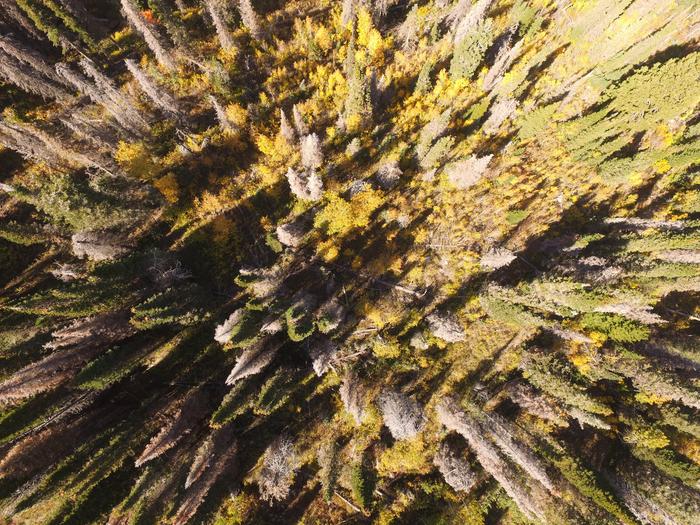A nonnative tree-killing insect is invading northern Utah, attacking subalpine fir and potentially triggering yet another die-off of the region’s long-stressed conifer forests.

Credit: Mickey Campbell, University of Utah
A nonnative tree-killing insect is invading northern Utah, attacking subalpine fir and potentially triggering yet another die-off of the region’s long-stressed conifer forests.
Introduced from central Europe into the Pacific Northwest about a century ago, the balsam woolly adelgid, or BWA, first detected in Utah in 2017 and has been spreading around the Wasatch Mountains, visibly affecting many of the popular recreation canyons outside Salt Lake City.
New research from the University of Utah, conducted in partnership with the U.S. Forest Service, has documented the current extent of the adelgid infestation and created a model for predicting its severity around the Uinta-Wasatch-Cache National Forest.
The study documented a clear relationship between the infestation’s severity and temperature, according to lead author Mickey Campbell, a research assistant professor in the Department of Geography (soon to be merged with the Environmental Studies program and renamed the School of Environment, Society and Sustainability.)
“We took that climate-to-severity relationship along with a series of climate projections and we were able to map current and future exposure to BWA damage at a high spatial resolution,” Campbell said. “The idea [is], in 2040, 2060, 2080, and 2100, based on these different climate projections, determining how exposed these areas are to the potential damaging effects of BWA. And indeed, we find that for an insect that prefers warmer areas, a warming climate is going to provide it with more opportunity to cause damage.”
The study appears this month in the journal Forest Ecology and Management. Co-authors include U Biology Professor William Anderegg, director of the Wilkes Center for Climate Science and Policy. [The center hosts its annual Climate Summit on May 14-15, where Anderegg will give opening remarks.]
The study, which was funded by the Forest Service, is also intended to provide land managers with tools to predict and mitigate future damage as the BWA infestation spreads. The team created an on-line interactive dashboard that illustrates how the insect damage is expected to unfold in the Uinta-Wasatch-Cache National Forest.
Covering the Wasatch, Uinta, Bear River and a few lesser mountain ranges in northern Utah, this forest is among the nation’s busiest for recreation.
Aside from an appetite for conifers, this new arrival to Utah has little in common with the native bark beetles that have devastated stands of lodgepole pine, ponderosa and Engelmann spruce all over the West in recent decades. While beetles gnaw away and burrow through the phloem under the trees’ bark, the much smaller, flightless adelgid sucks out the trees’ fluids and leaves behind a toxic saliva.
“It inserts its stylet, which is like a feeding tube, between the cells of the bark, and eventually finds parenchyma cells and it feeds on the fluids and starches that are contained within those parenchyma cells,” said study co-author Justin Williams, an entomologist with the Forest Service’s Forest Health Protection program.
While slurping, the insect excretes a substance that weakens the tree’s defenses and causes damage that impedes the flow of nutrients between root and crown, he said. The saliva promotes abnormal cell growth that results in the tell-tale signs of “gouting,” the appearance of swollen branch nodes.
Infested trees can die with three to five years, while white fir withstand infestation with no apparent ill effects.
The research team documented the current extent of Utah’s BWA infestation by staking out 58 plots in the Wasatch and Uinta mountains, each 30 meters in diameter, covering just under one fifth of an acre and each containing 150 to 200 trees. Every fir tree larger than 5 centimeters in diameter was evaluated on the severity of infestations based on the presence of gouting, woolly deposits adelgid leave on the trunk, crown deformities, and dead needles.
The research concluded 41% of the study area’s subalpine fir biomass is climatically exposed to some level of damage. And by 2100 under even moderate climate projections, 79% will be exposed, with 37% predicted to feature relatively high severity.
In Farmington Canyon north of Salt Lake City, where BWA was first documented in Utah, subalpine fir is experiencing widespread mortality.
“Maybe that’s because it’s been there the longest,” Campbell said, “but also maybe there’s something geographic about that area that makes it more susceptible to damage from the insect.”
Journal
Forest Ecology and Management
Method of Research
Observational study
Subject of Research
Not applicable
Article Title
Quantifying current and potential future impacts of balsam woolly adelgid infestation on forest biomass
Article Publication Date
15-May-2024
COI Statement
The authors declare the following financial interests/personal relationships which may be considered as potential competing interests: Michael Campbell reports financial support was provided by US Department of Agriculture Forest Service. If there are other authors, they declare that they have no known competing financial interests or personal relationships that could have appeared to influence the work reported in this paper.



